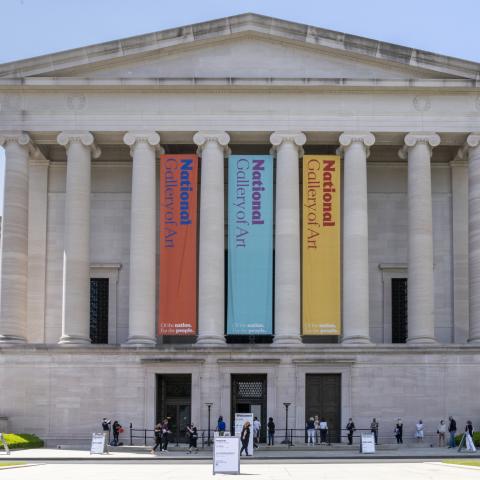The Pistoia Crucifix
c. 1600/1616
Artist, Florentine, 1577 - 1640


West Building Ground Floor, Gallery G10
Artwork overview
-
Medium
bronze
-
Credit Line
-
Dimensions
overall (corpus): 86.9 x 79 x 20.6 cm (34 3/16 x 31 1/8 x 8 1/8 in.)
overall (cross): 167 x 90.1 cm (65 3/4 x 35 1/2 in.) -
Accession
1973.9.1
Artwork history & notes
Provenance
Probably made for, or contemporaneously purchased for, Church of S. Maria degli Angeli, Pistoia [convent suppressed 1867, church closed 1886]; art market, Florence, early 1900s; purchased by Count Giorgio Piccolomini Adami [d. 1943], Siena; by inheritance to Contessa Piccolomini, Siena; private collection, Rome, by 1954; private collection, Switzerland, by 1958; purchased 1968 by (Heim Gallery, London); Angus Hood, England;[1] purchased 13 May 1974 through (Heim Gallery, London) by NGA.
[1] This object, along with others from the Hood collection, was on deposit at the City Museum and Art Gallery, Birmingham, England, from 1969 to 1973. The Heim Gallery's index card file of objects sold, no. W6298, confirms the Hood collection provenance (Getty Research Institute, Heim Gallery Records, Box 108).
Associated Names
Exhibition History
1974
Recent Acquisitions and Promised Gifts: Sculpture, Drawings, Prints, National Gallery of Art, Washington, D.C., 1974, no. II, repro.
Bibliography
1984
Torriti, Piero. Pietro Tacca da Carrara. Genova, 1984: 91, 93 - 96, repro.
1991
Kopper, Philip. America's National Gallery of Art: A Gift to the Nation. New York, 1991: 295, repro.
1994
Sculpture: An Illustrated Catalogue. National Gallery of Art, Washington, 1994: 223, repro.
2000
National Gallery of Art Special Issue. Connaissance des Arts. Paris, 2000:61.
2001
Baldry Beccatini, Francesca. Il Crocifisso di Pietro Tacca a Settignano. Restauro di un’inedita cartapesta policroma. Florence, 2001: 24-25, repro.
2007
Montigiani, Vanessa. In Franca Falletti, ed. Pietro Tacca. Carrara, La Toscana, le grandi corti europee. Exh. cat. Carrara, Centro internazionale delle arti plastiche, 2007: 88-90, repro., n. 100-101.
Inscriptions
on banner at top of cross: INRI
Wikidata ID
Q63854783


